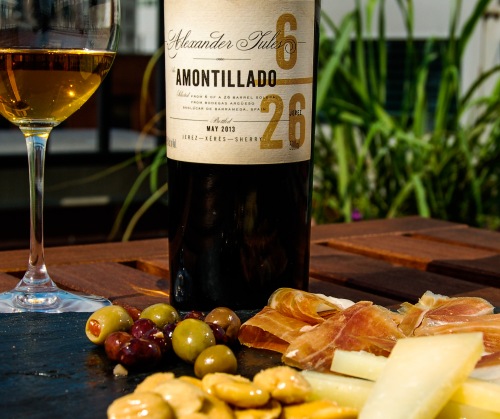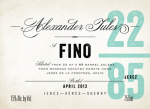Images
An American In Jerez
Image Posted on Updated on
When Alex Russan was a young college student he had his first taste of sherry. In an instant, he was hooked. “It was the most complex thing I had ever tasted. The unique flavors really moved me.” In the following years, the California native worked as a coffee buyer and simply indulged his passion for sherry the way most of us do, by simply drinking a lot of it. As the sherry renaissance began to flourish, however, his entrepreneurial instincts kicked in, and he saw an opportunity to turn his passion for sherry into a business. The result is Alexander Jules, a line of limited production, barrel-selected sherries, which made their debut last fall.
Sherry business is an old business, dominated by big shippers who can often trace their lineage back to the early 18th century. Many of them have been British—Harveys Bristol Cream, Byass of González-Byass, Sandeman—but Russan is the first American to bottle Jerez sherries. One of the factors that makes this possible is the fragmented structure of the industry. Rarely do the producers, who age and bottle the wine, own their own vineyards. Most buy their base wine from growers or an already aged wine from an almacenista. Traditionally, the goal for many of the sherry houses has been to maintain consistency, which is accomplished through blending the different barrels in their soleras, which are themselves blends of vintages. Beginning in the 1980s, however, Lustau recognized a market for smaller, more artisanal sherries and began bottling wines from individual almacenistas and featuring their names on the label. More recently, Equipo Navazos entered the market with their La Bota series, sherries from selected barrels that they thought expressed unique character but weren’t being bottled and sold. Bodegas can have hundreds of barrels (González Byass is the largest with 80,000), but inevitably not all are commercialized. This is where Equipo Navazos, and now Alexander Jules, have stepped in.
Having honed his palate over the years with specialty coffee (there are many similarities with wine) and recognizing that the interest in sherry was only growing stronger, Russan took the leap and, in August of 2012, began contacting the Jezez bodegas. The owners were all open to his proposal. “I was pleased with how receptive people were.” During his first trip to the region he tasted through barrels at 15 bodegas. “Once I have a sense of the spectrum of variation in the solera, I have an idea of what I’d like to focus on or accentuate in that solera. I’ll search for the barrels I feel represent that and will work well together. I look for complexity, cleanliness, precision of flavor, depth and elegance.” A few thousand emails and calls later, he bottled his first wines in May 2013.
In the last few years sherries have been increasingly bottled en rama, which means with minimal or no clarification or filtering before being bottled. This keeps the wine’s inherent characteristics as intact as possible and adds to the complexity and body. It’s as close to tasting a sherry in barrel as possible. Although Russan’s sherries are not labeled as such they are minimally treated. “Before en rama bottlings were common, most Finos and Manzanillas seemed fairly lean, austere wines, however, tasting them from the barrel they are often weighty, lush wines.” These in-barrel qualities are what he seeks to preserve in bottle.
Having tracked down a bottle of the 6/26 Amontillado at Slope Cellars, a wine store in Brooklyn, I can say that the sherry delivers in spades. This particular wine comes from a 26 barrel solera from Bodega Argüeso in Sanlúcar de Barrameda, a city on the Atlantic coast and the home turf of Manzanillas. The wine spent five years under flor followed by another five years aging oxidatively. Out of those 26 barrels Russan selected wine from 6 of them to be bottled, hence the 6/26. Per Russan’s instructions I sampled it over the course of four days. Initially this golden wine smelled of roasted almonds and camomille, a distinctive quality found in Manzanilla sherries. On the palate it was bone dry and crisp but with a soft, creaminess to the body. Flavors of mushrooms, raisins, baguettes, and brine went on a surprisingly long time. A day later the smell of butterscotch rose to the fore before receding the next day. By day 4 the butterscotch had been overtaken by scents of mapled walnuts and raisins. On the palate it remained crisply dry and creamy and tasted of camomille, almonds and olives. I did as the Spanish do and paired it with Iberico ham, Marcona almonds, and Manchego cheese.
In addition to the Alexander Jules 6/26 Amontillado, 500 ml, $40, Russan currently has two other sherries on offer: Alexander Jules Manzanilla 17/71, which comes from a nearly 200-year-old solera at the same bodega as the Amontillado and is bottled en rama, and Alexander Jules Fino 22 /85 from the Fino Celestino solera at Sanchez Romate in Jerez de la Frontera. These wines are aged an average of eight years and also bottled en rama.
His future plans include another release of the Manzanilla and Amontillado as well as a new Fino, but the real highlight, he says is an “old Oloroso from barrels that were untouched for about 40 years, after having been essentially lost.” These barrels were initially filled with about 500 liters (of already old wine). After 40 years there’s been significant ullage, leaving about about 200 liters. “A really intriguing, concentrated wine and a unique story.”





